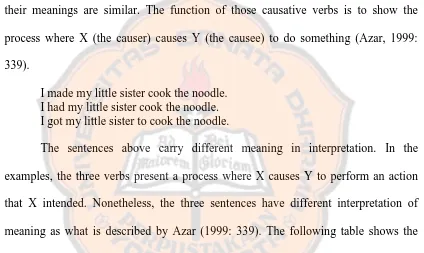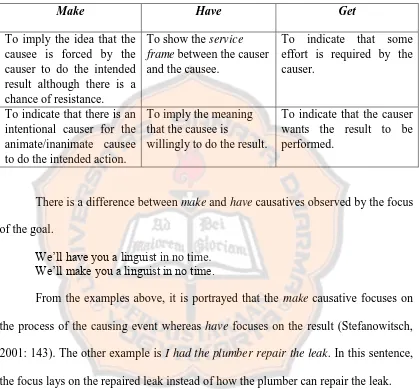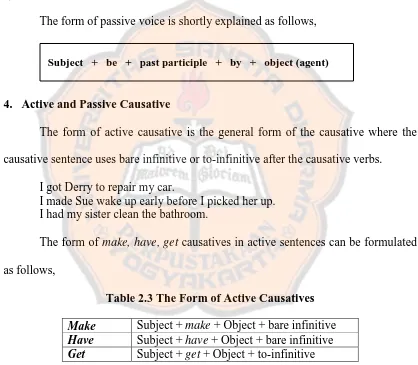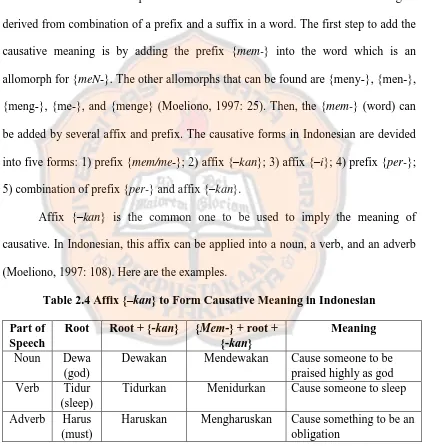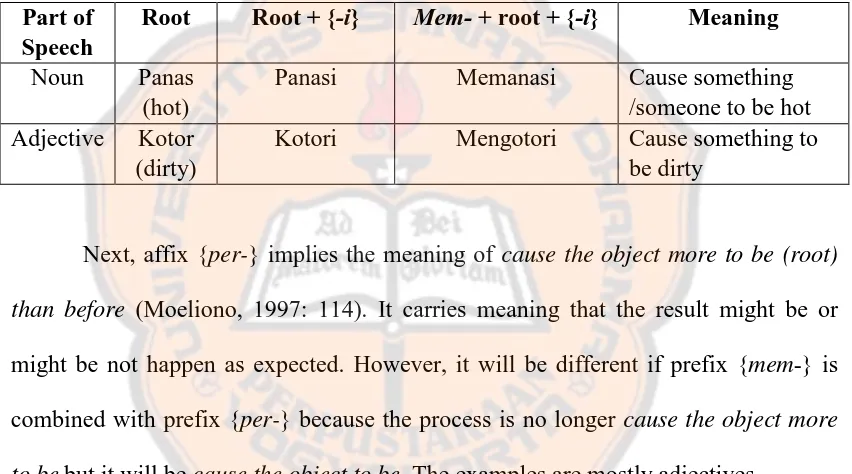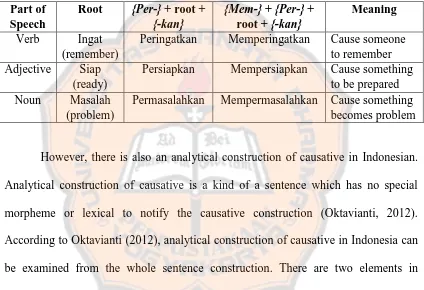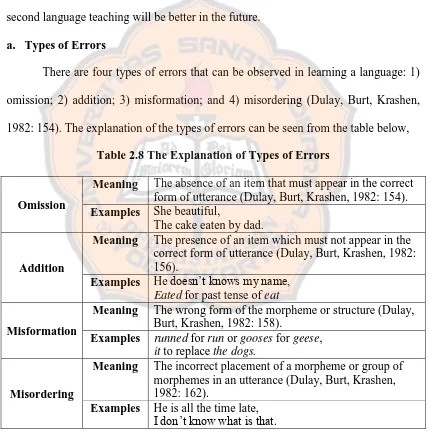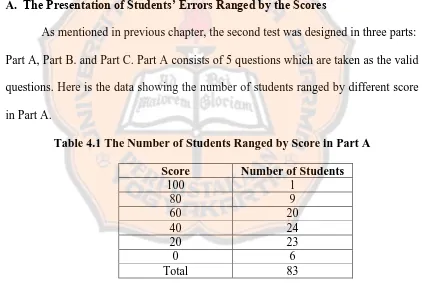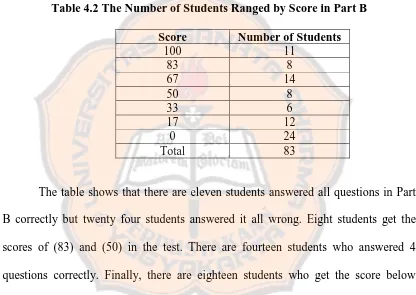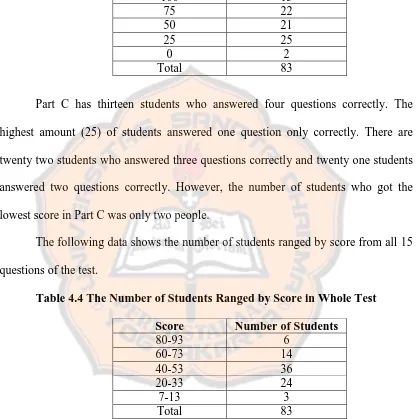THE MASTERY OF MAKE, HAVE, GET CAUSATIVES
AMONG THE SEVENTH SEMESTER STUDENTS
OF ENGLISH LETTERS DEPARTMENT
OF UNIVERSITAS SANATA DHARMA
AN UNDERGRADUATE THESIS
Presented as Partial Fulfilment of the Requirementsfor the Degree of Sarjana Sastra
in English Letters
By
DEVI WIJAYANTI Student Number : 134214057
ENGLISH LETTERS STUDY PROGRAM
DEPARTMENT OF ENGLISH LETTERS
FACULTY OF LETTERS
UNIVERSITAS SANATA DHARMA
YOGYAKARTA
ii
THE MASTERY OF MAKE, HAVE, GET CAUSATIVES
AMONG THE SEVENTH SEMESTER STUDENTS
OF ENGLISH LETTERS DEPARTMENT
OF UNIVERSITAS SANATA DHARMA
AN UNDERGRADUATE THESIS
Presented as Partial Fulfilment of the Requirementsfor the Degree of Sarjana Sastra
in English Letters
By
DEVI WIJAYANTI Student Number : 134214057
ENGLISH LETTERS STUDY PROGRAM
DEPARTMENT OF ENGLISH LETTERS
FACULTY OF LETTERS
UNIVERSITAS SANATA DHARMA
YOGYAKARTA
vii
The mind is everything
What you think, you become
viii
Dedicated to
my hard-working parents
Bu Sawitah and Pak Yitno
ix
ACKNOWLEDGEMENTS
Firstly, I would like to say that I am grateful for finally finishing my undergraduate thesis. This thesis is a proof of all hard-working processes I have been through for five months. Lucky me, I have wonderful parents who always support me in these four years of studying in university. I could not be more thankful for their tons of love and advice in life.
I am highly indebted to my advisor, Anna Fitriati, S.Pd., M.Hum., who gave me valuable guidance and great suggestion along the process of this final thesis. I would like to deliver my gratitude to Adventina Putranti, S.S, M.Hum. and Harris Hermansyah Setiajid M.Hum. who gave me permission to conduct the test in their classes. This thesis would not be successful without the help of Arina Isti’anah S.Pd., M.Hum. as my co-advisor who had helped me in the process of the writing of Chapter I until Chapter III and also had given detailed revision that improved this thesis to be much better than before.
Furthermore, I should give my greatest thanks to all my friends in the seventh semester whose names may not all be enumerated for participating in the test and questionnaire. Their help was very priceless to me. Most importantly, I’d like to thank Ryan for his support and for his always-listening-time. Last but not least, the completion of this thesis could not have been possible without my supportive friends. All of the unforgettable sharings and experiences we had have completed my lovely journey in these amazing years.
x
LEMBAR PERNYATAAN PERSETUJUAN PUBLIKASI KARYA ILMIAH.. vi
MOTTO PAGE ... vii
CHAPTER II: REVIEW OF LITERATURE ... 6
A. Review of Related Studies ... 6
4. Active and Passive Causative ... 13
5. Causative in Indonesian ... 15
xi
1. Data Collection ... 24
a. Test ... 26
b. Questionnaire ... 27
2. Data Analysis ... 27
a. Reliability and Validity ... 27
b. Scoring ... 29
CHAPTER IV: ANALYSIS RESULTS AND DISCUSSIONS... 30
A. The Presentation of Students’ Errors Ranged by the Scores... 30
B. Types of Students’ Errors ... 33
Appendix 2: The Proposal of Conducting the Test ... 64
Appendix 3: Reliability of the First Test ... 65
Appendix 4: Reliability of the Second Test ... 66
Appendix 5: The Validity of the First Test ... 67
Appendix 6: The First Test ... 69
Appendix 7: The Second Test ... 72
xii
LIST OF TABLES
Table 2.1 The Meanings of Make, Have, and Get Causatives... 10
Table 2.2 The Functions of Make, Have, and Get Causatives... 11
Table 2.3 The Forms of Active Causatives... 13
Table 2.4 Affix {-kan} to Form Causative Meaning in Indonesian... 15
Table 2.5 Affix {-i} to Form Causative Meaning in Indonesian... 16
Table 2.6 Prefix {per-} to Form Causative Meaning in Indonesian... 16
Table 2.7 Prefix {Per-} and Affix {-kan} to Form Causative Meaning in Indonesian... 17
Table 2.8 The Explanation of Types of Errors... 19
Table 4.1 The Number of Students Ranged by Score in Part A... 30
Table 4.2 The Number of Students Ranged by Score in Part B... 31
Table 4.3 The Number of Students Ranged by Score in Part C... 32
Table 4.4 The Number of Students Ranged by Score in Whole Test... 32
Table 4.5 Data of Errors in Part A... 33
Table 4.6 Data of Errors in Part B... 39
Table 4.7 Data of Students’ Answers in Part C... 51
xiii
LIST OF CHARTS
xiv
LIST OF ABBREVIATIONS
A Addition
KBBI Daring Kamus Besar Bahasa Indonesia Dalam Jaringan
MF Misformation
MO Misordering
O Omission
OAD Oxford Advanced Dictionary
SA Student’s Answer
TL Target Language
X The Causer
xv ABSTRACT
WIJAYANTI, DEVI (2017). The Mastery of Make, Have, Get Causatives Among The Seventh Semester Students of English Letters Department of Universitas Sanata Dharma. Yogyakarta: Department of English Letters, Faculty of Letters, Sanata Dharma University.
English grammar is one of the important aspects that needs to be learned in learning English, especially as a foreign language. Causative is one of English grammar that refers to the verbs which show a process of an agentive subject causing another agent to do an action. However, according to researcher’s experience as a grammar tutor in the Department, causative was one of the materials in English grammar that was not easy to be understood by the students. Based on the material taught in Structure classes, the researcher decided to take make, have, get as the verbs of causative as the data to analyze.
There are two problems formulated in this research. The first is the type of errors that the seventh semester students have in learning causatives. The second are the factors behind the errors.
This research conducted a quantitative method with syntax and translation as the approaches. The researcher used a test as the instrument which was held twice. The first test was on purpose to search for the validity and reliability. The second test was the actual test that was used as the measurement of students’ comprehension towards the material. The researcher also distributed questionnaire for additional data related with the topic.
The result shows that students’ comprehension about make, have, get
causatives is below average. This is proven by the data of 63 students who get the score under 60 and 20 students get the score of 60-93. Most of the answers have misformation type of error. However, addition, omission, and misordering errors are also found out in the students’ answers. These errors include the errors in differentiating meaning and function between make, have, get causatives; passive form of causative; and transferring the meaning of causative into Indonesian. Interlanguage is one of the factors causing the problem which includes the way that students overgeneralized the meaning of make and get in Indonesian and false concept of passive structure between Indonesian and English. The other is intralanguage which is the failure in understanding passive causative structure and overgeneralization of function between make, have, get causatives. However, it is also shown in the result that many students have understood the active structure of causatives. Overall, the students confessed that they still had the lack of knowledge of
xvi ABSTRAK
WIJAYANTI, DEVI (2017). The Mastery of Make, Have, Get Causatives Among The Seventh Semester Students of English Letters Department of Universitas Sanata Dharma. Yogyakarta: Program Studi Sastra Inggris, Fakultas Sastra, Universitas Sanata Dharma.
Ketatabahasaan Bahasa Inggris adalah salah satu aspek penting yang perlu untuk didalami dalam mempelajari Bahasa Inggris, terutama sebagai bahasa asing. Kausatif adalah salah satu dalam ketatabahasaan Bahasa Inggris mengenai kata kerja yang menunjukan sebuah proses oleh subjek agentif yang menyebabkan agen lain untuk melakukan suatu tindakan. Namun, menurut pengalaman peneliti sebagai seorang asisten dosen di Departemen, kausatif adalah salah satu materi dalam ketatabahasaan Bahasa Inggris yang tidak mudah untuk dipahami oleh para mahasiswa. Berdasarkan materi yang diajarkan dalam kelas Structure, peneliti menentukan untuk mengambil make, have, get sebagai kata kerja kausatif.
Terdapat dua masalah yang dirumuskan di penelitian ini. Pertama, yakni jenis kesalahan yang mahasiswa semester tujuh hadapi dalam mempelajari kausatif. Kedua, yakni faktor-faktor penyebab di balik kesalahan.
Penelitian ini mengadakan metode kuantitatif dengan sintaksis dan penterjemahan sebagai pendekatannya. Peneliti menggunakan tes sebagai instrumen yang diadakan sebanyak dua kali. Tes pertama ditujukan untuk mencari validitas dan reliabilitas. Tes kedua adalah tes sesungguhnya yang digunakan sebagai pengukur pemahaman mahasiswa tentang materi tersebut. Peneliti juga membagikan kuesioner untuk data tambahan yang berhubungan dengan topik kausatif.
Hasil menunjukkan bahwa pemahaman mahasiswa mengenai kausatif make, have, get adalah di bawah rata-rata. Hal ini dibuktikan dari data 63 mahasiswa yang mendapat skor di bawah 60 dan 20 mahasiswa yang mendapat skor 60-93. Sebagian besar jawaban memiliki jenis kesalahan misformation. Namun, kesalahan addition, omission, dan misordering juga ditemukan dalam jawaban mahasiswa. Kesalahan-kesalahan ini termasuk Kesalahan-kesalahan dalam membedakan arti dan fungsi antara kausatif
make, have, get; bentuk kausatif pasif; dan mentrasfer makna kausatif ke dalam Bahasa Indonesia. Interlanguage adalah salah satu faktor yang menyebabkan masalah di mana hal ini termasuk cara mahasiswa terlalu menyamaratakan makna make dan
1 CHAPTER I INTRODUCTION
A. Background of the Study
Language holds the most important role in the process of communicating with
other people. In Indonesia, there are two types of language used for daily use,
Indonesian and English. Indonesian is used by people to communicate with other
Indonesian people. However, the use of English is not very significant in the daily
language in Indonesia, except for certain purposes such as for business and academic
communication. Due to the need of learning English as an international language,
English has been included in educational learning process. Therefore, English has
been included in the school curriculum as a non-obligatory subject of KTSP 2013
from Junior High School, Senior High School, and University level in Indonesia.
In order to understand English, there are some significant aspects to be
learned, one of them is grammar. Grammar concerns the principles of constructing
acceptable formation of words, phrases, and sentences as well as the principles of
interpreting the meaning (Radford, 2002: 1). One example of grammar is learning
how to produce a sentence in different sequence of time, whether in the past, present,
or future which is learned in the level of high school curriculum. However, grammar
which is taught in the level of university, especially in such of English Department,
will be more complex such as learning how to make a noun phrase, how to use and
One subject included in advance level of English Grammar is the construction
of causative. Causatives refer to the verbs that portray a process when an agent causes
another agent to perform an action (Celce-Murcia, Marianne and Larsen Freeman,
1999: 355). Causative verbs indicating this process include make, have, get. Although
they have a similar purpose, they have differences in the usage. Causative make
includes a sense of ‘forcing’ someone to do something; causative have includes a
sense of ‘request’, and causative get includes a sense of ‘persuade’ in its use (Azar,
1999: 339).
Causatives are chosen as the topic based on the writer’s experience as a
grammar tutor who taught the material to the fourth semester students of English
Letters Department of Universitas Sanata Dharma in 2016. To be more specific,
causatives were included in the syllabus of Structure II in the second semester,
Structure IV in fourth semester and Structure V in the fifth semester. In the teaching
process, the students admitted that they have learned causatives, specifically the get
and have causatives, before the second semester. However, they were still confused
with the topic. Based on causative exercises given, the writer found out that the
biggest difficulty that most of the students had was the use of passive and active
causative as well as how to use make, have, get correctlyin a sentence. For example,
the students were asked to fill the blank with active or passive causative. The question
was,
The right answer of the question is gets cleaned. However, some students did not pay
attention to the instruction that they answered it with regular passive sentence, has
been cleaned.
As it is shown in the example, make, have, and get causatives deal with the
formulation of active and passive sentence. It is important for students to learn the
construction of active and passive causative due to their different formulation with
the passive voice and their different interpretations in meaning. The students also
need to master causative make, have, get for its benefit of language use in daily life. In order to improve student’s understanding in causatives, this research is
aimed to find out the reasons behind the error. There are several researchers’ hypotheses on how the errors can happen, and one of them is the different process of
second language learning that the students have been through. It is known that most
people, no matter what their first language is, learn English structure in a fairly set
order (Dulay, Burt, and Krashen, 1982: 5). In this case, some internal and external
factors have big impact in the process of English learning. Later, this research will
include some theories which analyze the factors that influence the second language
acquisition.
The reason behind choosing seventh semester students of English Letters
Department as the sample of the study was because of the consideration that they
have learned all the Structure subjects, including causatives. It was also assumed that
the seventh semester students have applied their understanding of causative in all of
The study will limit the topic causative into three parts. First, the study will
cover the material of different use and different purpose of make, have, get
causatives. Second, the scope of the study will include the construction of active and
passive causative make, have, get. Third, the topic will include the understanding
about make, have, get causatives in Indonesian. Later, these three objects of study
will be tested to the seventh semester students in order to find out the mastery of
causative that they have learned before.
B. Problem Formulation
The research problem of this study is formulated as follows,
1. What types of error that seventh semester students have in causatives?
2. What factors cause the error?
C. Objectives of the Study
The purpose of this study is to find out the problem of causatives that the
seventh semester students have and to find out how well the students master the
causatives. The problem that causes the error may include the problems in learning
the meaning of causatives: distinguishing the use of make, have, get as causative
verbs; using the implementation of active and passive causative; and the
interpretation of meaning of English causatives in Indonesian.
The objective of the study is to identify what causes the students’ errors in
learning causatives. The problem could be caused by several factors such as the
factor which could be the way of delivering topic by the teacher (Richards, 1979: 190). Moreover, this research will focus on the students’ internal factors.
D. Definition of Terms
There are three terms that will be defined in this part. First, the word ‘mastery’ means as an acquisition that requires deep understanding or comprehending certain knowledge. Furthermore, ‘mastery’ requires personal features such as
maturity, tact, sensitivity, and adaptability which enable the individual to observe and imitate what others do, and to search the language’s resources to find expression to
suit his attitude (Quirk, R., Greenbaum, S., Leech, G., & Startvik, J., 1972 :24). In the
process of learning second language, the term ‘mastery’ is often used to estimate how well a person learns the second language.
Second, the term ‘errors’ means flawed side of learner’s speech or writing. In this research, the ‘errors’ are those parts of composition or writing that deviate from
selected norm of mature language performance (Dulay, Burt, and Krashen, 1982 : 38). In short, the ‘errors’ are the mistakes done by the learners who are not following
the language rules.
Third, the term ‘causative’ refers to the causal relationship between alternative
versions of a sentence (Crystal, 2008: 70). Crystal examines that the example can be
seen from the pair of sentences of The cat killed the mouse and the mouse died. The
6 CHAPTER II
REVIEW OF LITERATURE
A. Review of Related Studies
Kristi (2003) conducted a research of the mastery of causative, specifically get
and have causatives, towards the high school students in Yogyakarta. At the
beginning, Kristi introduced causative verbs in Old English and Modern English.
Later, she explained have and get causatives followed by their meanings, functions,
and tenses.
There were three objectives of the study. First, the study aimed to find out
how many students of SMK Dharma Paramitha Yogyakarta have mastered get and
have causatives. Second was to find out the difficulties that the students had in the
process of understanding causatives. Third, the research was done to investigate the
reason behind the difficulties in mastering get and have causatives.
To answer the problems, Kristi used a test and questionnaire as the instrument
in this study. There were 20 people of third grade students at SMK Dharma
Paramitha who participated in the test and questionnaire. The computation showed
that two students got an A, three students got B, ten students got C, and five students
got D.
The result of the research were the object of errors that the students did. It was
proven that they have difficulties on the structure, such as putting the major
get and have as causative verbs, and understanding English tenses. Kristi also found
out the causes of the problems in understanding causatives which were: 1) the source
of the material, 2) the choice of the material itself and the style of presentation, and 3)
forgetful learners.
The next related study was from Gilquin (2003) who conducted a research on
the relation and differences between get and have causatives. In practice, Gilquin
examined that these two verbs shared similarities such as: (1) they could govern an
infinitive, past participle, or present participle; (2) both of them did not have the
passivization system of the main-clause; and (3) they could be followed by a
non-finite clause but expressed a different non-causative meaning, notably an experiential
one. In spite of these similarities, get and have causatives have differences in the
construction and semantics.
In short, Gilquin investigated the elements in causative such as the causer,
causee, patient, and effect. These elements of get and have causatives then were
compared to each other. The results were: 1) the frequency of get causatives was
higher than have; 2) get and have causatives had different in purpose; and 3) get and
have causatives had different form of sentence.
The research result by Kristi will be used as the basic hypotheses for this
research. The researcher would like to find out whether the difficulties in causatives proved in Kristi’s research are also felt by seventh semester students of English
Letters Department. In the other hand, the research done by Gilquin will be used as
B. Review of Related Theories 1. Grammar
Grammar is a set of rules which specify all the possible structures of the
language. Therefore, all of the production of words and sentences of a language are
set systematically by the rules. The structure of language includes the structure of
word and sentence.
In English, understanding a language is started from understanding the word
construction and the word function, for example: the word sing has a function of
verb, which it shows an action or the activity done by the doer. In this case, it is
important to acknowledge part of speech which is divided into ten types, for instance
noun, adjective, verb, preposition, and so on (Quirk and Greenbaum, 1985: 18).
Then, it is continued with the learning of producing a phrase, a clause, and a sentence.
In addition, it is also needed to learn the tenses in English such as present progressive
tense, past tense, future tense, etc.
It is indeed that combining the words to make a sentence needs an acceptable
pattern which is based on the systematic rules. The knowledge of grammar rules is
required in order to build up a good connection throughout language so people can
talk and understand what the speaker is saying and what meanings that the speaker is
2. Causative
The term ‘causative’ refers to one of word-formations which is a group of
verbs including some of transitive verb, intransitive verb, and auxiliary verbs that indicate the underlying structure of ‘cause’ towards something implicitly or explicitly
(Kastovsky, 1973 : 256). Causative verbs involve an agent who does such an action to
cause another agent to do an action as the agent intended (Celce-Murcia, Marianne
and Larsen Freeman, 1999: 653), or to cause another thing to produce a change from
its preceding position or situation. Therefore, the involvement of two or more people
in causative construction is divided into two: the causer and the causee
(Stefanowitsch, 2001: 35).
The causer is the entity, animate or inanimate, that brings about the caused
event or generally known as a subject or an agent (Gilquin, 2003: 127). The causee is
the opposite which is the entity that is changed or influenced by the causer and carries
out the effect of the caused event which is usually has the function as the object (Gilquin, 2003: 127). The causative construction or the “linguistic organization of
causation construal” will be referred to as causativity (Stefanowitsch, 2001: 11).
There are four types of complementation of causatives explained by
Stefanowitsch (2001: 5) :
a) Causative verbs followed by bare infinitive after the causee, e.g. make, have
b) Causative verbs followed by to-infinitive after the causee, e.g. force, get,
c) Causative verbs followed by present participle after the causee, e.g. send,
leave.
d) Causative verbs followed by to-present participle after the causee, e.g. set.
a. Meaning and Function
Each causative verb of make, have, get has different interpretation though
their meanings are similar. The function of those causative verbs is to show the
process where X (the causer) causes Y (the causee) to do something (Azar, 1999:
339).
I made my little sister cook the noodle. I had my little sister cook the noodle. I got my little sister to cook the noodle.
The sentences above carry different meaning in interpretation. In the
examples, the three verbs present a process where X causes Y to perform an action
that X intended. Nonetheless, the three sentences have different interpretation of
meaning as what is described by Azar (1999: 339). The following table shows the
different meanings and interpretations based on the examples above,
Table 2.1 The Meanings of Make, Have, and Get Causatives
Make Interpretation occurs because Y habitually does the action.
Meaning
It suggests a routine hiring as between costumer and bussiness person.
Get Interpretation X managed to persuade Y to cook the noodle.
In short, here are the differences of make, have, get causatives in function.
Table 2.2 The Functions of Make, Have, and Get Causatives
Make Have Get
There is a difference between make and have causatives observed by the focus
of the goal.
We’ll have you a linguist in no time. We’ll make you a linguist in no time.
From the examples above, it is portrayed that the make causative focuses on
the process of the causing event whereas have focuses on the result (Stefanowitsch,
2001: 143). The other example is I had the plumber repair the leak. In this sentence,
the focus lays on the repaired leak instead of how the plumber can repair the leak.
In other circumstances, there is a similarity between get and have which they
have little or no difference in meaning in the form of passive voice (Azar, 1999: 339).
In the following examples, there is no different interpretation in meaning and both
have and get have the same function.
3. Active and Passive Voice
The general form of active voice has a function to perform the doer or the
agent as the subject of the clause (Celce-Murcia, Marianne and Larsen Freeman,
1999: 343). For example, the sentence of Darwin studied the fauna of the Galapagos
islands shows that the speaker emphasizes Darwin as the subject who does such an
action. However, it is possible if the sentence emphasizes the object of the sentence.
Therefore, the sentence can be changed into The fauna of the Galapagos islands was
studied by Darwin. In this case, the object of the active sentence is changed to be the
subject of the sentence. This form of sentence is called the passive voice.
Azar explains the function of passive voice into two. First, passive voice is
most frequently used when the subject (agent) is not known or is not important to be
mentioned (Azar, 1999: 211). For examples:
Rice is grown in Indonesia (by the farmer). My house was built in 1996 (by the workers).
Second, passive voice can be used to emphasize the object of the active
sentence although the speaker knows who perform the action (Azar, 1999: 211). For
examples:
The sweater was made by my grandmother. This delicious cake was cooked by Anie.
There are also some considerations to insert the agent in the passive sentence.
First, the agent may be inserted when the agent is a new information (Celce-Murcia,
Marianne and Larsen Freeman, 1999: 355), for example: Jill’s purse was snatched by
Marianne and Larsen Freeman, 1999: 355), for instance: I don’t know whether all my
data will be blocked by the server. Third, the agent can be mentioned if the agent is a
well-known person and when it is used as additional information (Celce-Murcia,
Marianne and Larsen Freeman, 1999: 355), for example: The Mona Lisa was painted
by Da Vinci.
The form of passive voice is shortly explained as follows,
4. Active and Passive Causative
The form of active causative is the general form of the causative where the
causative sentence uses bare infinitive or to-infinitive after the causative verbs.
I got Derry to repair my car.
I made Sue wake up early before I picked her up. I had my sister clean the bathroom.
The form of make, have, get causatives in active sentences can be formulated
as follows,
Table 2.3 The Form of Active Causatives
Make Subject + make + Object + bare infinitive Have Subject + have + Object + bare infinitive Get Subject + get + Object + to-infinitive
From the examples, there is a similar pattern of active causative: the subject
(causer) is followed by the causative verb which is directly followed by the object
the existence of the object or the person who is doing the job. However, the person
who is doing the job is not the causer or the subject of the main clause but it is the
causee. Therefore, it is significant in the active causative to mention the object.
In the other side, passive causative is used when the speaker does not know or
does not want to mention who is doing the job. Like the passive voice, passive
causative also uses past participle in the causing event.
I finally had the lawn mowed. I finally got the lawn mowed.
The passive form of make causative will be slightly different from the passive
form of get and have. For example, the sentence John made Mary bake a cake will
have two possible passive forms:
John made a cake (be) baked (by Mary) Mary was made to bake a cake (by John).
It is rare and almost never happens in English the form of passive causative in
the first sentence of examples. In fact, it is also rare to find make causative in the
passive form. The acceptable passive form of make causative is in the second
sentence of examples where John is optional to be mentioned. This makes the passive
causative form of make is similar with the regular passive voice:
Subj(causer) + have/get + complement + past participle + by obj(causee) (optional)
5. Causative in Indonesian
Causative in Indonesian has different characteristics compared to make, have,
get causatives in English. Indonesian has the suffix and prefix form to create
causative word. It is also possible in some words that the causative meaning is
derived from combination of a prefix and a suffix in a word. The first step to add the
causative meaning is by adding the prefix {mem-} into the word which is an
allomorph for {meN-}. The other allomorphs that can be found are {meny-}, {men-},
{meng-}, {me-}, and {menge} (Moeliono, 1997: 25). Then, the {mem-} (word) can
be added by several affix and prefix. The causative forms in Indonesian are devided
into five forms: 1) prefix {mem/me-}; 2) affix {–kan}; 3) affix {–i}; 4) prefix {per-};
5) combination of prefix {per-} and affix {–kan}.
Affix {–kan} is the common one to be used to imply the meaning of
causative. In Indonesian, this affix can be applied into a noun, a verb, and an adverb
(Moeliono, 1997: 108). Here are the examples.
Table 2.4 Affix {–kan} to Form Causative Meaning in Indonesian Part of
Dewakan Mendewakan Cause someone to be praised highly as god Verb Tidur
(sleep)
Tidurkan Menidurkan Cause someone to sleep
Adverb Harus (must)
Affix {–i} has a different process compared to affix {–kan} because it
changes the object condition, rather than just explaining the result (Moeliono, 1997:
112). The examples are menerangkan and menerangi. Menerangkan means to cause
(a problem) becomes clearer while menerangi means to cause (a room/surface)
becomes lighter. Most of the roots in this affix group are nouns and adjectives.
Table 2.5 Affix {–i} to Form Causative Meaning in Indonesian
Part of
Kotori Mengotori Cause something to be dirty
Next, affix {per-} implies the meaning of cause the object more to be (root)
than before (Moeliono, 1997: 114). It carries meaning that the result might be or
might be not happen as expected. However, it will be different if prefix {mem-} is
combined with prefix {per-} because the process is no longer cause the object more
to be but it will be cause the object to be. The examples are mostly adjectives.
Table 2.6 Prefix {per-} to Form Causative Meaning in Indonesian
Last, Indonesian also has combination of prefix {per-} and affix {–kan}
which implies the meaning cause the object to be. The example of memperlihatkan
implies the meaning of cause the object to be seen. This combination happens with
verb, adjective, and noun. See the examples at the table below.
Table 2.7 {Per-} and {–kan} to Form Causative Meaning in Indonesian Part of
Persiapkan Mempersiapkan Cause something to be prepared
morpheme or lexical to notify the causative construction (Oktavianti, 2012).
According to Oktavianti (2012), analytical construction of causative in Indonesia can
be examined from the whole sentence construction. There are two elements in
analytical construction of causative in Indonesian which are the reason and the effect.
For example, in the sentence ‘Ali membuatku sedih’ has Ali as the reason and sedih as
the effect (Oktavianti, 2012). The verbs signing for this structure are membuat,
menyuruh, memaksa, membujuk, etc. Nonetheless, this construction of causative is
6. Errors
Crystal explains the term ‘error’ as the mistakes in spontaneous speaking or
writing (2008: 173). The error may involve difficulties with timing or sequence
commands that will lead to the addition, deletion, or substitution of sounds and
morphemes (Crystal, 2008: 173). Crystal explains this phenomenon as ‘slips of the tongue (2008: 173). Dulay, Burt, and Krashen define ‘error’ as the kind of any
deviation from selected norm or language performance, no matter what the
characteristics or causes might be (1982: 139). Overall, ‘error’ is the deviation,
mostly unintended, which appears on speaking or writing due to several causes.
In language and teaching learning, error analysis is a technique for
identifying, classifying, and interpreting the unacceptable forms produced by second
language learners (Crystal, 2008: 173). Some linguists assume that the error made by
second language learners may have relation to the adaptability of the second language
to the mother language. However, the cause such as the lack of knowledge of the
rules of the language is also one of the reasons of why the cause can happen (Dulay,
Burt, and Krashen, 1982: 139).
Error analysis has been well-spread learned by the linguists, especially
teachers, to analyze the difficulty that the students have in learning the second
language. As the explanation done by Dulay, Burt, and Krashen, there are two major purposes of studying learners’ errors: 1) it provides data from which inferences about
the nature of the language learning process can be made; and 2) it indicates to
which error types detract most from a learner’s ability to communicate effectively
(1982: 138). The identification of errors holds a significant step in this research that it
will involve a comparison between what the learners have produced and what a native
speaker will produce in the same context (Ellis and Barkhuizen, 2005: 58). By
identifying and analyzing the factors of errors, it is hoped that the development of
second language teaching will be better in the future.
a. Types of Errors
There are four types of errors that can be observed in learning a language: 1)
omission; 2) addition; 3) misformation; and 4) misordering (Dulay, Burt, Krashen,
1982: 154). The explanation of the types of errors can be seen from the table below,
Table 2.8 The Explanation of Types of Errors
Omission
Meaning The absence of an item that must appear in the correct form of utterance (Dulay, Burt, Krashen, 1982: 154). Examples She beautiful,
The cake eaten by dad.
Addition
Meaning The presence of an item which must not appear in the correct form of utterance (Dulay, Burt, Krashen, 1982: 156).
Examples He doesn’t knows my name,
Eated for past tense of eat
Misformation
Meaning The wrong form of the morpheme or structure (Dulay, Burt, Krashen, 1982: 158).
Examples runned for run or gooses for geese,
it to replace the dogs.
Misordering
Meaning The incorrect placement of a morpheme or group of morphemes in an utterance (Dulay, Burt, Krashen, 1982: 162).
b. Causes of Errors
Error analysis consists of the procedures to identify, describe, and explain the learners’ errors (Ellis and Barkhuizen, 2005: 51). The four types of errors that have
been explained before have different sources. Some universal sources are omission,
overgeneralization, and trasfer errors (Ellis 2003: 19). Omission is the way that
learners leave out some important elements in the correct form utterance (Ellis 2003:
19). Learners also overgeneralize rules and meaning in a structure of language to
make it easy to be processed (Ellis 2003: 19). Last, trasfer errors are the errors that
cause the learners to shape and create their own rules of a language (Ellis 2003: 19). Transfer errors usually reflect the structure of learners’ first language.
In the error analysis of second language learners, it is common to observe that
the mistakes done by the speaker or the writer are because of their adaptation of their mother tongue language into second language. For instance, ‘She beautiful’ is derived
from the Indonesian language ‘Dia cantik’. The non-existence of be ‘is’ in the
Indonesian language then is adapted into English which results error in the language.
This sort of error is called interlanguage errors that are errors caused by the interference of the learner’s mother tongue (Richards, 1979: 173). Some linguists call
this error as interlingual (Dulay, Burt, Krashen 1982: 108; Brown, 1987: 102). Brown
explains interlingual errors as follows,
Talking about interlingual errors means talking about second language
acquistion which is the way in which people learn another language besides their
mother tongue language (Ellis, 2003: 3). There are internal and external factors that
cause the way second language learners acquire the second language acquisition. The internal factors are: first, the learners’ cognitive mechanism to extract information
about second language structure and grammar; and second, learners’ language
aptitude (Ellis, 2003: 5). The external factors include the social conditions and the
input that the learners receive (Ellis, 2003: 4).
Another error is called intralingual and developmental errors which are the errors that reflect the learner’s competence at a particular stage, and illustrate some of
the general characteristics of language acquisition (Richards, 1979: 173). Intralingual
errors are the errors that commonly happen in the progress of second language
learning. These errors include the mistakes in syntax and word formation such as the
overgeneralization of past simple form of –ed in go which becomes goed, are for be
following will, etc (Brown, 1987: 178).
C. Theoretical Framework
The theories explained above will be used to support the writer’s analysis in
the research. The comprehension of grammar will be the basic knowledge for the
writer to construct the question for the respondents, which will be explained in the
next chapter, and to analyze the material dealing with the sentence construction in the
answer. The theories about causative in English and causative in Indonesian are
Later, the theory of active and passive voice as well as active and passive
causative will be used for the considered component to measure the mastery of make,
have, and get causatives. These theories are related to the finding for the first problem
formulation, whether the error can occur in the grammar construction, the
understanding of causative meaning, or the construction of active and passive
causative.
The last, the theory of errors including its types and its causes is going to be
the supportive element to analyze the data and also to answer the second problem. The respondent’s data then will be measured and analyzed by theory of quantitative
23 CHAPTER III METHODOLOGY
A. Object of the Study
The objects of this research were the seventh semester students of 2016
academic year, in English Letters Department of Universitas Sanata Dharma. The
reason was the background knowledge that the seventh semester students had toward
the material. The writer expected that the seventh semester students had mastered the
material because they had learned Structure I until Structure V.
Since causative is related to sentence form, the mastery of causative would be
measured based on the correct form of sentences the seventh semester students
produced in causative. This would include the mastery on the differentiation of
causative function and comprehension of active and passive causative. Therefore, the
linguistic element that would be analyzed was the syntactic form of sentence.
B. Approach of the Study
The first approach of the study applied in this research was the syntactic
approach. Syntax concerns with the way how words can be combined together to
form phrases and sentences (Radford, 2002: 1). Crystal explains that syntax is ‘the
study of the interrelationships between elements of sentence structure’ (2008: 471).
Furthermore, the syntactic approach would be applied to analyze the structure of
active and passive causative in the test given to seventh semester students. The
Since this research dealt with the second language acquisition, the second
approach used to analyze it was translation method. Hatim and Munday explains
translation method as follows,
Translation is an incredibly broad notion which can be understood in many different ways. For example, one may talk of translation as a process or a product, and identify such sub-types as literary translation, technical translation, subtitling and machine translation; moreover, while more typically it just refers to the transfer of written texts, the term sometimes also includes interpreting (2004: 3).
This translation method would be used to analyze how the students could understand
the difference between make, have, get English causatives in Indonesian form. That is
why the approach uses a closed translation as a part of the methodology.
C. Method of the Study 1. Data Collection
To help analyzing data, the writer decided to use quantitative method.
Quantitative research lets the investigator identify a research problem based on the
observation or on the need to explain why something occurs (Creswell, 2015: 13).
Sugiyono illustrates quantitative method as a research method which is used for
analyzing certain population or sample in statistical way (2014: 35). In order to
support the methodology, the researcher used sample for the obejct for the research
taken from the students’ population.
Population is the group or persons, things, or events that share at least one
common trait (Sprinthall, Schmutte, and Sirois, 1990: 27). In this research, the
Department at Universitas Sanata Dharma in 2016 academic year and had passed the
Structure I until Structure V.
A sample is a smaller number of observations taken from the total number
making up a given population (Sprinthall, Schmutte, and Sirois, 1990: 28).
Furthermore, Creswell explains that sample is the subgroup of the population for
generalizing about the target population (2015: 141). The chosen sample must
represent the population or otherwise the conclusion can not be accepted (Sugiyono,
2013: 149). Therefore, there is a systematic way to decide how many people who can
be taken as the sample of a research. Here is the formula by Isaac and Michael in
Sugiyono (2013, 158):
Chart 3.1 Sample Formula �2. N. P. Q
s = ---
�2 � − + �2. .
s = the amount of sample
λ2
= Chi Quadrate that depends on the degree of mistakes (1%; 5%; and 10%) N = the number of population
P = the opportunity of true (0,5) Q = the opportunity of false (0,5)
d = the difference between sample’s average with population’s average. It could be
0,01; 0,05 and 0,1
The population of seventh semester students who had passed Structure V is
to 24 seventh semester students. Due to the need of taking sample as the
representation, there would be 83 students of the seventh semester (see appendix 1).
a. Test
A test is a method to measure someone’s ability or knowledge in a given area
which has the purpose of measuring (Brown, 1987: 219). The kind of test given was
called achievement test, a test that was related to classroom lessons, units, or
curriculum and limited to particular material (Brown, 1987: 225).
The test would be divided into three parts. The first part aimed to find out
whether the seventh semester students had acknowledged enough the different
function between make, have, get and the active form of causative. The second
section aimed to find out the comprehension of passive causative form. The third
section would consist of four questions where the students translated the question in
Indonesian into English in causative form.
The test done by the researcher contained of two kinds of test. The first test
was given to measure the validity of the questions that the researcher had writen.
Here, it can be said that the first test was the experimental test in order to get the
result of the number of questions that the researcher can use for the real test (see
appendix 6). The second test was the actual test that is used to measure students’
comprehension about the topic (see appendix 7). To be clear, the first test was the test
given to 24 students, which were taken in Seminar on Language Class A on 7
Pragmatics Classes on 23-28 November 2016 (see appendix 2). The test result used
for analyzing the mastery of causative that students had is the second test.
b. Questionnaire
Creswell in Sugiyono demonstrates that questionnaires are forms used in a
survey design that participant in a study complete and returns to the researcher (2013:
230). The questionnaire in this research would be a closed questionnaire. The
instruments would be focusing on: 1) the way the students learned and practiced
Structure and 2) the comprehension of causative material especially make, have, and
get. The questions would be multiple choice questions that each option had different
score.
Based on the experiment done in the first test, the researcher gave 10
questions in the questionnaire which question (1), (2), and (4) are proven not valid
(see appendix 8). Later, the researcher will only consider the rest valid questions.
2. Data Analysis
a. Reliability and Validity
The test has to through the process of validity and reliability of instrument in
order to be dependable. Reliability measures the instrument (in this case is the test) to
achieve consistent result (Brown, 1987: 220). Consistency in this context means that
the result will be the same from the day the test taken with the result taken next week
after, or at least fulfil the same expectation. Reliability in this research would be
√ ∑ 2 ∑ 2
halves (Sprinthall et al, 1990: 35). Spearman Brown formula would be used for the
reliability test (Sugiyono, 2013: 220):
Chart 3.2 Formula for Reliability ��
r1 = __________ + ��
r1 = internal reliability of all instruments
rb = product correlation moment first half and the second
In order to achieve rb, then the Pearson product moment formula was needed
as follows:
Chart 3.3 Formula for Product Correlation Moment (rb) ∑
rb =_______________________
∑xy = sum of the x times y scores ∑x2
= sum of the x squared scores
∑y2
= sum of the y squared scores rb = Person correlation moment
Validity, however, is the degree which the test measures what should be
measured (Brown, 1987: 221). To get the valid result, the instrument used for
measuring the data has to be valid as well. The high validity of instruments will give
Validity calculation would include the correlation technique that needed qualification
of validity if rb = 0,3 (Sugiyono, 2013: 218).
After the test had been conducted, the result showed that only 15 from all of
36 questions tested to students were valid. Each question has different correlation
moment which then compared to the acceptable amount of correlation moment (r =
0,3). The details of validity measurement can be seen in appendix 5, while the
questions of the first test can be seen in appendix 6.
The split-half techniques is used by distinguishing the questions into two
halves which were odd-numbered items and even-numbered items. The result of
reliability of the first test was 0,97 and 0,96 for the second test (see appendix 3 and
appendix 4)
b. Scoring
The test score would be divided into two parts: correct answer and incorrect
answer. The correct answer would be given score 1 for each and the incorrect number
would be given score 0. The scores were calculated and the result would be used to
analyze the type of errors and difficulties that the students dealt with in make, have,
30
CHAPTER IV
ANALYSIS RESULTS AND DISCUSSIONS
In this chapter, it will be explained the detailed analysis of type of errors that
students did in the test and causes of errors. This chapter will be started with the
description of the test result, continued with the explanation of the type of errors as
well as the causes of the errors in the incorrect answers.
A. The Presentation of Students’ Errors Ranged by the Scores
As mentioned in previous chapter, the second test was designed in three parts:
Part A, Part B. and Part C. Part A consists of 5 questions which are taken as the valid
questions. Here is the data showing the number of students ranged by different score
in Part A.
Table 4.1 The Number of Students Ranged by Score in Part A Score Number of Students
100 1
80 9
60 20
40 24
20 23
0 6
Total 83
It is shown in the table that only one student who was successful to answer all
incorrect answer. The rest of students, 63 students in total, have score (20-60). The
other fact is that there are six students who answered all the questions incorrectly.
Part B consists of six essay-questions about changing active-causative
sentences into passive-causative sentences. The table below shows the result of the
number of students ranged by the score.
Table 4.2 The Number of Students Ranged by Score in Part B
Score Number of Students
100 11
83 8
67 14
50 8
33 6
17 12
0 24
Total 83
The table shows that there are eleven students answered all questions in Part
B correctly but twenty four students answered it all wrong. Eight students get the
scores of (83) and (50) in the test. There are fourteen students who answered 4
questions correctly. Finally, there are eighteen students who get the score below
average, which are (33) and (17) as the scores. In short conclusion, there are 19
students who get score above 80, and there are 64 students who get score below 70.
Last, the students’ second language acquisition is measured in Part C which
contains of four questions. Here, the students were asked to choose one they thought
Table 4.3 The Number of Students Ranged by Score in Part C
Score Number of Students
100 13
75 22
50 21
25 25
0 2
Total 83
Part C has thirteen students who answered four questions correctly. The
highest amount (25) of students answered one question only correctly. There are
twenty two students who answered three questions correctly and twenty one students
answered two questions correctly. However, the number of students who got the
lowest score in Part C was only two people.
The following data shows the number of students ranged by score from all 15
questions of the test.
Table 4.4 The Number of Students Ranged by Score in Whole Test
Score Number of Students
80-93 6
60-73 14
40-53 36
20-33 24
7-13 3
Total 83
The result shows that there is none of students who could answer all the
questions in the test correctly and there is no student who gets score (0). There are six
(60-73). It is clear that there are twenty students who achieve score above (60).
Meanwhile, as many as thirty-six students achieve score (40-53), and twenty four
students have (20-33) as the score. Finally, the data shows that there are three
students who answered two from fifteen questions correctly.
B. Types of Students’ Errors
The explanation of students’ errors will be divided by each part of the test:
Part A, Part B, and Part C. Part A contains of several questions that aim to find out
students’ comprehension of different functions between make, have, get causatives
and the form of active-causatives. Part B is designed to measure students’ ability to
understand the change of active-causatives into passive-causatives. Part C is designed
to measure students’ second language acquisition. The errors in students’ answers
will be categorized into four types: misformation, omission, addition, and
misordering.
1. Students’ Errors in Part A
Part A has five valid questions in the result. The table below shows the data of
errors ranged by error types.
Table 4.5 Data of Errors in Part A
Note: MF Misformation; MO Misordering
Type of Error
The Number of Error in Question: Total Errors
1 2 3 4 5
MF 58 67 36 34 10 205
The calculation of mistake shows that question number (1) and question
number (2) have the biggest number of misformation errors. Meanwhile question
number (4) has misordering as the other type of error. For the record, misformation is
the most common mistakes which is found in Part A.
a. Misformation
Part A lets the students choose the incorrect words or group of words in each
question (see appendix 7). Here, questions (1), (2), (4), and (5) contain the items to
test whether the students can differentiate the function and meaning of make, have,
get causatives. Questions (2), (3), (4), and (5) contain the options that are used to
measure the comprehension of active causative form that the students had learned.
One common error that most of students did is to misunderstand different
meaning and function of make, have, get causatives. Misformation error happening in
question (2) can be observed from the data of 64 students answered option B (fix) as
the incorrect word in the sentence.
Question (2) : We got our landlord fix the broken windows. A B C
Here, question (2) includes get and have causatives as the item for the test. By
this question, it is hoped that students can decide the right causative verb to complete
the sentence. By answering option B (fix), the students had resulted misformation
error that was choosing the wrong word in the sentence.
The right answer should be ‘We had our landlord fix the broken window’.
the causer we and the causee landlord. The sentence describes a situation where we
engage the service of the owner of the land to bring about the effect (Stefanowitsch,
2001: 131).
There are some indications why the students answered option B (fix). Get
causative has the form of to-infinitive following the verb. As a result, the students
agreed that fix in the sentence should be changed with to fix and decided that option B
(fix) as the incorrect word to be put in the sentence. It implies that the students
acknowledge the active-causative form of get due to the form of to-infinitive that
comes after get. If it is so, the students had succeeded to understand the active form
of get, but failed to differentiate the meaning of get causative with the other causative
verbs in a sentence.
The other indication is the way students tried to maintain get as the causative
verb due to the meaning of get: to be connected with somebody. If it is combined
with the meaning of get in students’ first language, the sentence can be translated as:
‘Kami menghubungi pemilik tanah untuk memperbaiki jendela yang rusak’.
However, if get is translated into menghubungi or contact, it will not produce a
causative sentence which has the causer we to influence the causee landlord to do the
intended action. It will be different if get is replaced by contact because it will
produce a new meaning: the one who fixes the broken window is not the landlord but
There are also some mistakes done by the students about the false structure in
a sentence. An example is taken from question (1) where 36 students answer option B
(seeing) while the incorrect word in the sentence should be B (made).
Question (1): Debbie’s husband hated the opera. But after days of nagging,
A
she finally made him to go seeing the new production of La
B C
Boheme.
The right answer is get as the causative verb to replace option B (made). Get
causative has the appropriate meaning to connect the causer and the causee which is
to persuade. The meaning of causer persuading causee is also supported by the phrase
‘but after days of nagging’.
Seeing in the sentence is the gerund form that comes after go to express
recreational activity (Azar, 1999: 303). Therefore, option C (seeing) is not the
incorrect word in the sentence.
Linguistically, there are two indications behind the choice C (seeing) that the
students chose. First, students might think seeing is not appropriate verb for
connecting the phrase because La Boheme is an opera. The students probably think
that the verb watching is more suitable verb for the sentence instead of seeing.
Second, the phrase to go seeing the new production of La Boheme can result an
indication that it is a non-finite clause. Non-finite clause as the object has the form of
to-infinitive or –ing participle (Quirk, 1972: 361). If it is seen from the non-finite
clause point of view, the phrase ‘to go seeing the new production of La Boheme’ as
used at the same time. The error that the students choose option C (seeing) as the
answer is categorized as misformation error; the use of wrong word.
Next, question (4) is aimed to test whether the students can differentiate the
function of make and have causatives.
Question (4) : Romantic movies always have her cry. A B C
The result shows that about 42 students answer question (4) correctly. The
students answered option B (have) as the incorrect word in the sentence. This
portrays that students have acknowledged the difference between have and make
causatives in its function and meaning.
The students also have understood well the active form of causative. It can be
observed by the high number of correct answer in question (3) and (5). There are 34
students who correctly answer question (3) and 69 students have correct answers in
question (5).
Question (3): My boss makes me work overtime every day last week. A B C
Question (5): Mr. Levine had his secretary call to Ms. Jackson and reconfirm A B
their meeting on Thursday. C
In question (3), the students recognized the adverb of time last week and
decided that option A (makes) should be changed with past tense form made. It
implies that students have acknowledged the form of past tense sentence as well as
to-infinitive in a sentence which causes them to choose option B (call to) as the incorrect
item in question (5). In the other side, the choice of option B (call to) for question (5)
is also a sign that the students have known the rule of have causative which have is
followed by infinitive.
b. Misordering
Misordering is the other error type that students did in question (4). Although
most of students had answered the question corretly, there were five students who
answered option A (always) as the incorrect word in the sentence. Here is the
question for number (4) Part A:
Question (4): Romantic movies always have her cry. A B C
The word always in the sentence describes habitual activity. This is the
reason why always is put between the subject and the causative verb. Nonetheless,
some of students might think that always in this sentence is the incorrect word for the
question (4). It is probably because always also can be used in present or past
progressive for special circumstances, such as expression or anger and complaint
(Azar, 1999: 30). In this case, students might consider the presence of be are/were
before the word always in the sentence, thus influencing them to choose option A.
Overall, the result of Part A in the test shows that most of the students have
understood the active-form of causatives. On the contrary, some of the results show
that the students still have some mistakes in differentiating the differences of
2. Students’ Errors in Part B
Part B contains of six questions; (6), (7), (8), (9), (10), (11), of active
causative sentences. Here, the students are instructed to change the active sentence
into passive causative form. The purpose of the six questions is to find out how far
the students’ comprehension about passive causative form.
In order to sum up the result of test in Part B, some steps were taken by the
researcher to make the analysis better. All of error types that have been explained in
Chapter III are found out in each question. The following table shows the number of
each error.
Table 4.6 Data of Errors in Part B
Note: MF Misformation; A Addition; MO Misordering; O Omission
Type of Error
The Number of Error in Each Question Total Errors
